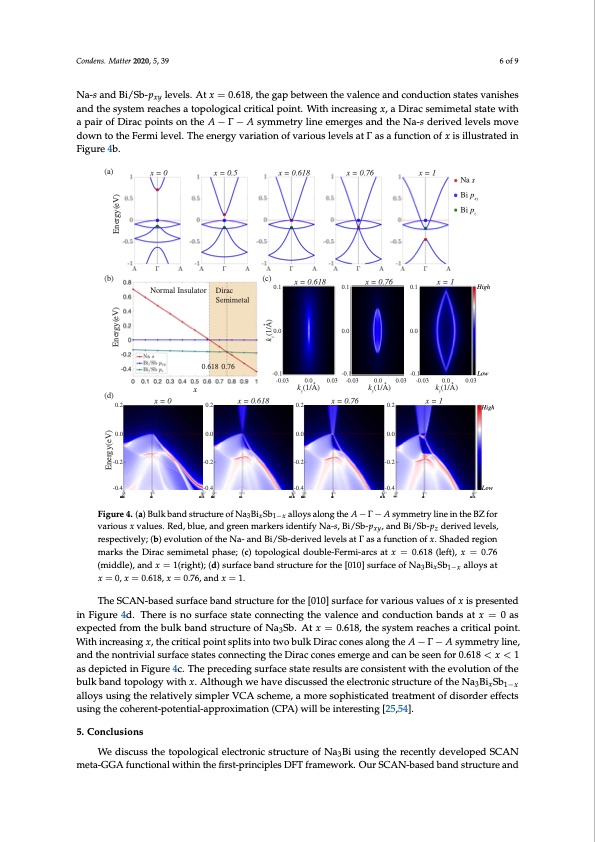
PDF Publication Title:
Text from PDF Page: 006
Condens. Matter 2020, 5, 39 6 of 9 Na-s and Bi/Sb-pxy levels. At x = 0.618, the gap between the valence and conduction states vanishes and the system reaches a topological critical point. With increasing x, a Dirac semimetal state with a pair of Dirac points on the A − Γ − A symmetry line emerges and the Na-s derived levels move down to the Fermi level. The energy variation of various levels at Γ as a function of x is illustrated in Figure 4b. (a) x = 0 x = 0.5 Dirac Semimetal x = 0.618 x = 0.76 0.1 x = 0.76 0.0 x = 1 0.1 x = 1 0.0 Na s Bi pxy Bi pz (b) Normal Insulator (c) 0.1 0.0 x = 0.618 Low High Low 0.03 0.618 0.76 (d) x y y y 0.2 x = 0 0.2 x = 0.618 0.2 0.0 0.0 High Low x k (1/Å) 0.0 k (1/Å) -0.1 -0.03 -0.1 -0.03 0.0 -0.1 -0.03 0.0 0.0 k (1/Å) 0.03 x = 0.76 0.03 0.2 x = 1 0.0 -0.2 -0.4 -0.4 -0.4 -0.4 -0.2 -0.2 -0.2 Figure 4. (a) Bulk band structure of Na3BixSb1−x alloys along the A − Γ − A symmetry line in the BZ for various x values. Red, blue, and green markers identify Na-s, Bi/Sb-pxy, and Bi/Sb-pz derived levels, respectively; (b) evolution of the Na- and Bi/Sb-derived levels at Γ as a function of x. Shaded region marks the Dirac semimetal phase; (c) topological double-Fermi-arcs at x = 0.618 (left), x = 0.76 (middle), and x = 1(right); (d) surface band structure for the [010] surface of Na3BixSb1−x alloys at x = 0, x = 0.618, x = 0.76, and x = 1. The SCAN-based surface band structure for the [010] surface for various values of x is presented in Figure 4d. There is no surface state connecting the valence and conduction bands at x = 0 as expected from the bulk band structure of Na3Sb. At x = 0.618, the system reaches a critical point. With increasing x, the critical point splits into two bulk Dirac cones along the A − Γ − A symmetry line, and the nontrivial surface states connecting the Dirac cones emerge and can be seen for 0.618 < x < 1 as depicted in Figure 4c. The preceding surface state results are consistent with the evolution of the bulk band topology with x. Although we have discussed the electronic structure of the Na3BixSb1−x alloys using the relatively simpler VCA scheme, a more sophisticated treatment of disorder effects using the coherent-potential-approximation (CPA) will be interesting [25,54]. 5. Conclusions We discuss the topological electronic structure of Na3Bi using the recently developed SCAN meta-GGA functional within the first-principles DFT framework. Our SCAN-based band structure and Energy(eV) Energy(eV) Energy(eV) kz(1/Å)PDF Image | Topological Dirac Semimetal Phase in Bismuth Based Anode Materials for Sodium-Ion Batteries

PDF Search Title:
Topological Dirac Semimetal Phase in Bismuth Based Anode Materials for Sodium-Ion BatteriesOriginal File Name Searched:
condensedmatter-05-00039-v3.pdfDIY PDF Search: Google It | Yahoo | Bing
Sulfur Deposition on Carbon Nanofibers using Supercritical CO2 Sulfur Deposition on Carbon Nanofibers using Supercritical CO2. Gamma sulfur also known as mother of pearl sulfur and nacreous sulfur... More Info
CO2 Organic Rankine Cycle Experimenter Platform The supercritical CO2 phase change system is both a heat pump and organic rankine cycle which can be used for those purposes and as a supercritical extractor for advanced subcritical and supercritical extraction technology. Uses include producing nanoparticles, precious metal CO2 extraction, lithium battery recycling, and other applications... More Info
| CONTACT TEL: 608-238-6001 Email: greg@infinityturbine.com | RSS | AMP |